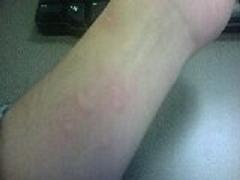Junior Martin Sicam knew he had a problem when he found splotches of human blood on his pillow and bed sheets.

Sicam, who lives in an off-campus apartment in Minneapolis, said the problem began three weeks ago when he started “getting bumps on (his) arms and legs that were really itchy, kind of like mosquito bites.”
“I didn’t really believe it until I saw one on my bed,” Sicam said.
What Sicam saw on his bed was a Climex lectularius, also known as the common bed bug. Bed bugs are parasitic insects that feed on human blood and are mainly active at night.
“It looked exactly like the one I saw online,” Sicam said. “They look kind of like flat, brownish-reddish ladybugs.”
Colin Brownlow, St. Thomas director of environmental health and safety, said he is trained to identify bed bug infestations and administer treatment methods. Brownlow said if students see tiny flecks of dried blood in their bedding, they should make an appointment with Student Health Services.
Sicam said he hasn’t slept in his bed for more than a week and probably won’t sleep in it for a month. He also said that despite washing his sheets in very hot water, his bed bug problem persists.
Junior Sheelue Yang also said she experienced bed bug issues in Grace Residence Hall on South Campus during the second semester of her sophomore year.
“I didn’t actually see anything. I just woke up with a bunch of red bumps that were itchy and constantly irritating,” Yang said.
Yang said that the problem persisted for two to three months, but she did not see a need to notify Residence Life or Student Health Services.
“Grace (Hall) was probably the worst for me. It was like four or five bites a night. I didn’t complain because I was so busy, and then I just kind of let it be,” she said.
Since Yang moved off campus, she said she hasn’t had any issues with bed bugs.
“I’m pretty positive that I’m not the only one who’s had problems because it happened pretty much all throughout my years on campus,” Yang said. “I’m sure it’s bed bugs. I mean, what else could it be?”
Though Sicam and Yang are both off-campus residents, they said they believe there is the potential for a bed bug outbreak on campus.
“(Bed bugs) can spread pretty fast. They’re hard to get rid of,” Sicam said.
However, Director of Residence Life Aaron Macke said that bed bugs are less common than people may think.
“Oftentimes, students might think it’s a bed bug, and it’s not,” he said.
Brownlow agreed.
“Some people react to chemicals in certain dryer sheets and detergents. Bumps and dermatitis are also a lot more common in winter,” Brownlow said.
Macke said that there have not been any bed bug cases since he started working at St. Thomas five years ago.
“If a student is concerned, we need them to let us know right away. We would work with Colin (Brownlow) to identify whether it is or isn’t bed bugs,” he said.
Brownlow said that although St. Thomas has had a couple of isolated complaints of bed bugs on campus this year, they have turned out to be false alarms.
He said if bed bugs are found, getting rid of them is a tough process.
“We would take all the bedding and wash it in high-temperature washers and dryers and work with the student and get their clothing dry-cleaned to kill the bed bugs,” Brownlow said.
Bronwlow added that there is only one direct way to get rid of the insects.
“Bed bugs have grown resistant to pesticides, so the only surefire way to get rid of them in a room is to bring in high-temperature portable heaters and heat the room up to over 140 degrees,” Brownlow said. “That kills the live bugs and dries out their eggs.”
Sicam offered this additional tip: “Keep washing your sheets. Something that we don’t have in my apartment is a vacuum cleaner, and I think that’s part of it too. Otherwise, there’s not much you can do,” he said.
Yang said that students should buy a mattress protector.
However, according to Macke, there is no need for students on campus to be concerned.
“Student travel tends to be one of the primary concerns or causes,” Macke said. “College students are a mobile population, and there’s always a risk of transporting one thing from one place to another. The risk is always there. But the reality is that it happens very little.
“When you think of all the college campuses and all the residents on all those campuses, it’s actually a pretty small problem. For us, thankfully it hasn’t been a problem at all.”
Amanda Ogbuehi can be reached at ogbu0322@stthomas.edu.

